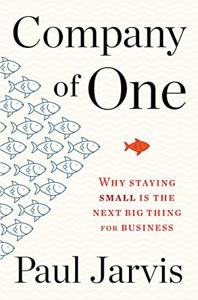
Want to learn the ideas in Company of One better than ever? Read the world’s #1 book summary of Company of One by Paul Jarvis here.
Read a brief 1-Page Summary or watch video summaries curated by our expert team. Note: this book guide is not affiliated with or endorsed by the publisher or author, and we always encourage you to purchase and read the full book.
Video Summaries of Company of One
We’ve scoured the Internet for the very best videos on Company of One, from high-quality videos summaries to interviews or commentary by Paul Jarvis.
1-Page Summary of Company of One
Overview
It doesn’t matter if you’re a one-person company or an employee of a larger organization. You can still apply the principles of being a Company of One to your work and benefit from them. For example, both large companies and programmers within those companies can use the idea that they should get their product out there as soon as possible in order to make money sooner rather than later.
When we think of success, many people think big. We visualize massive companies, blockbuster products and successful CEOs like Amazon or the iPhone. While this can be a good way to look at business success, it can also seem overwhelming. After all, your chances of starting the next industry-conquering giant or creating the next viral product sensation are pretty slim.
However, many people want to be a big business. They want their life to revolve around making money and finding new markets for their company. However, that can lead you to being overworked and not having time for the things you care about such as family or hobbies.
If you’re intrigued by the notion of thinking smaller about success, then these key points are for you!
In this book, you will learn how to turn a hobby into a small business that makes money and can be sustained. You’ll also find out how to do it without needing lots of funding for the endeavor.
Big Idea #1: Companies that are one in nature reject the idea of growth for the sake of growth. Instead, they adopt a more holistic view of life and focus on doing what’s best for themselves as well as their customers and employees.
Modern capitalism is based on the concept of having more. Consumers want to buy more products and services, while businesses want to produce more goods or provide additional services.
On the other hand, there’s a company that has to keep growing its sales. It wants to sell more products and services so it can make more money. Once it reaches one goal, it sets another even bigger target—$1 million then $10 million and so on.
In general, people want more. They are driven by an insatiable desire for consumption and growth.
Consumers are trying to limit their consumption. Some businesses are also starting to say “enough is enough” and want a more stable approach that will help them grow in the long run.
A number of businesses have decided to pursue a financial goal that’s different from what most companies do. They want to earn just enough money to allow their owners and employees the lifestyle they desire.
Businesses can be more successful if they focus on the desires of their customers. By turning those desires into the center of gravity around which their business revolves, businesses can revolve around individuals who run them and make sure that they’re happy. Those individuals will become the businesses’ unit of measure—a unit of one. Whether it’s a single owner-operator or a team consisting of hundreds, we can call this type of business a company-of-one because it focuses on what makes each person special and unique.
Most businesses set goals to grow as much as possible, but companies of one intentionally limit their growth. For example, Sean D’Souza runs a company that has $500,000 in profit per year as its goal. Even though he could make more money if he wanted to, he purposefully chooses not to grow his business beyond this amount.
Why not more? As the famous rapper Biggie Smalls said, “Mo’ money, mo’ problems.” Generally speaking, if you want to make more money, you need to produce and sell more products. That means more employees and infrastructure. And that means less comfort and free time. Therefore, it’s best to start a business with just enough revenue so that you can work on your own terms from home or anywhere else in the world that has an Internet connection.






